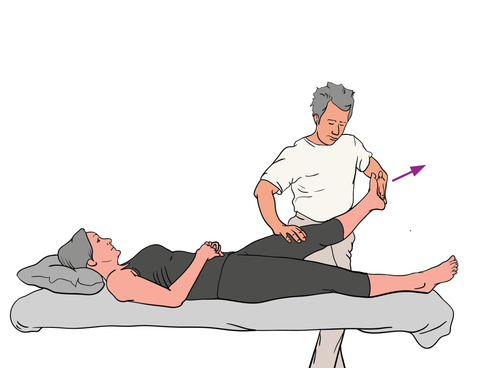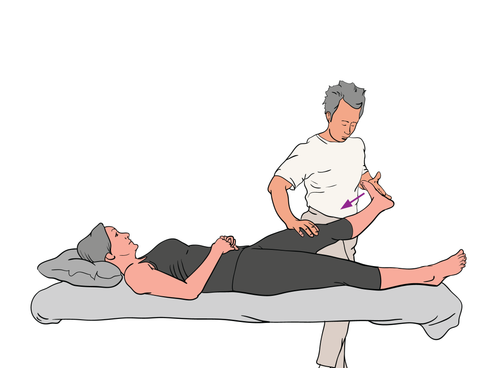Muscle Energy Technique - Gastrocnemius
Scroll down for step-by-step instructions for treating this muscle using the Muscle Energy Technique protocol

Gastrocnemius - Common Trigger Point Sites
Gastrocnemius
The gastrocnemius is part of the composite muscle known as the triceps surae, which forms the prominent contour of the calf.
The triceps surae comprises the gastrocnemius, soleus, and plantaris. The popliteal fossa at the back of the knee is formed inferiorly by the bellies of the gastrocnemius and plantaris, laterally by the tendon of the biceps femoris, and medially by the tendons of the semimembranosus and semitendinosus.
Trigger points in the gastrocnemius are typically associated with calf pain/stiffness, nocturnal cramps, foot pain (instep), and pain in the back of the knee on mechanical activity.
Assessment of Gastrocnemius
The patient’s left leg is placed across the therapist’s thigh. From this position, the therapist has control of the patient’s left lower limb and foot.
It is important to make sure that the patient’s leg is kept straight at the knee, as this will influence the test result.
The therapist gently encourages the patient’s left ankle into a dorsiflexed position until a bind is felt (see illustration below).
The normal range of motion should achieve 90 degrees; if the point of bind is felt sooner, the gastrocnemius is classified as short.

The therapist gently encourages the patient’s left ankle into a dorsiflexed position until a bind is felt. A range of motion of 90 degrees is normal.
Alternative Method for Testing the Muscle Length of the Gastrocnemius
This test can be performed if the patient has a normal range of motion in their hamstrings; if the hamstrings have been classified as short, the original test described above must be used.
The therapist passively takes the patient’s left leg to 90 degrees of hip flexion. From this position, the therapist controls the patient’s left lower limb and stabilizes the ankle.
The therapist slowly encourages the patient’s ankle into dorsiflexion and feels for a bind (as shown below). If a range of 90 degrees can be achieved with no resistance, the gastrocnemius is classified as normal.

Testing the gastrocnemius: a range of motion of 90 degrees is normal. This technique also gives an indication of hamstring length.
MET Treatment of Gastrocnemius
The patient is asked to push their toes away (plantar flexion) to activate the gastrocnemius (see figures (a) and (c) below).
After a 10-second contraction and on the relaxation phase, the therapist encourages dorsiflexion to promote lengthening of the gastrocnemius (see figures (b) and (d) below).

Figure (a) Contraction of Gastrocnemius

Figure (b) Lengthening of Gastrocnemius

Figure (c) The patient plantar flexes the ankle from 90 degrees of hip flexion

Figure (d) - after the contraction, the therapist encourages dorsiflexion of the ankle to lengthen the gastrocnemius
The Gastrocnemius is the very visible muscle that can be seen in the back of the lower leg. Together with the Soleus and Plantaris muscles they build what is known as the Triceps Surae, or can also be called the calf muscles.
The Gastrocnemius splits into two heads known as the Lateral head, the outer side, and Medial head, the inner side. Both of the Gastrocnemius heads start at the top of the calf, at the knee joint, meet in the lower middle part of the calf and together with the other muscles it ends attached to the achilles tendon. The Gastrocnemius is a power muscle which helps with moving the leg forward. It plays an important part in many exercises and everyday activities such as walking, running and jumping. Because the Gastrocnemius connects with the knee and the ankle joints, it helps the movement of both areas.
Some common injuries involving this muscle include (i) achilles tendonitis, inflammation to the achilles tendon which can occur from overuse of the muscle. (ii) Tennis leg which is felt by sharp pain in the calf, and may indicate a tear at the inner head of the Gastrocnemius. (iii) Achilles tendon tear, a tear to the tendon itself connected with the Gastrocnemius.
The Gastrocnemius is more vulnerable to becoming strained due to its location between the knee and ankle joints. If there is swelling to the muscle, pain while stretching and/or pain during movement of the connecting joints could indicate a Gastrocnemius strain.
There are many ways to strengthen the Gastrocnemius and to help keep it strong and healthy. Body weight movements such as squats, lunges and calf raises are some of the simple exercises that can be done pretty much anywhere.
The same exercises could also be used during weight workouts (adding weight), or with exercise bands. Running and jumping are movements that will also generally help strengthen the calf muscles, though should be carried out with awareness of movement.
Find a Trigger Point Professional in your area
Muscle Energy Technique (Online Course)
Muscle Energy Technique (Articles)
Dry Needling for Trigger Points
This trigger point therapy blog is intended to be used for information purposes only and is not intended to be used for medical diagnosis or treatment or to substitute for a medical diagnosis and/or treatment rendered or prescribed by a physician or competent healthcare professional. This information is designed as educational material, but should not be taken as a recommendation for treatment of any particular person or patient. Always consult your physician if you think you need treatment or if you feel unwell.
About Niel Asher Education
Niel Asher Education (NAT Global Campus) is a globally recognised provider of high-quality professional learning for hands-on health and movement practitioners. Through an extensive catalogue of expert-led online courses, NAT delivers continuing education for massage therapists, supporting both newly qualified and highly experienced professionals with practical, clinically relevant training designed for real-world practice.
Beyond massage therapy, Niel Asher Education offers comprehensive continuing education for physical therapists, continuing education for athletic trainers, continuing education for chiropractors, and continuing education for rehabilitation professionals working across a wide range of clinical, sports, and wellness environments. Courses span manual therapy, movement, rehabilitation, pain management, integrative therapies, and practitioner self-care, with content presented by respected educators and clinicians from around the world.
Known for its high production values and practitioner-focused approach, Niel Asher Education emphasises clarity, practical application, and professional integrity. Its online learning model allows practitioners to study at their own pace while earning recognised certificates and maintaining ongoing professional development requirements, making continuing education accessible regardless of location or schedule.
Through partnerships with leading educational platforms and organisations worldwide, Niel Asher Education continues to expand access to trusted, high-quality continuing education for massage therapists, continuing education for physical therapists, continuing education for athletic trainers, continuing education for chiropractors, and continuing education for rehabilitation professionals, supporting lifelong learning and professional excellence across the global therapy community.

Continuing Professional Education
Looking for Massage Therapy CEUs, PT and ATC continuing education, chiropractic CE, or advanced manual therapy training? Explore our evidence-based online courses designed for hands-on professionals.






















